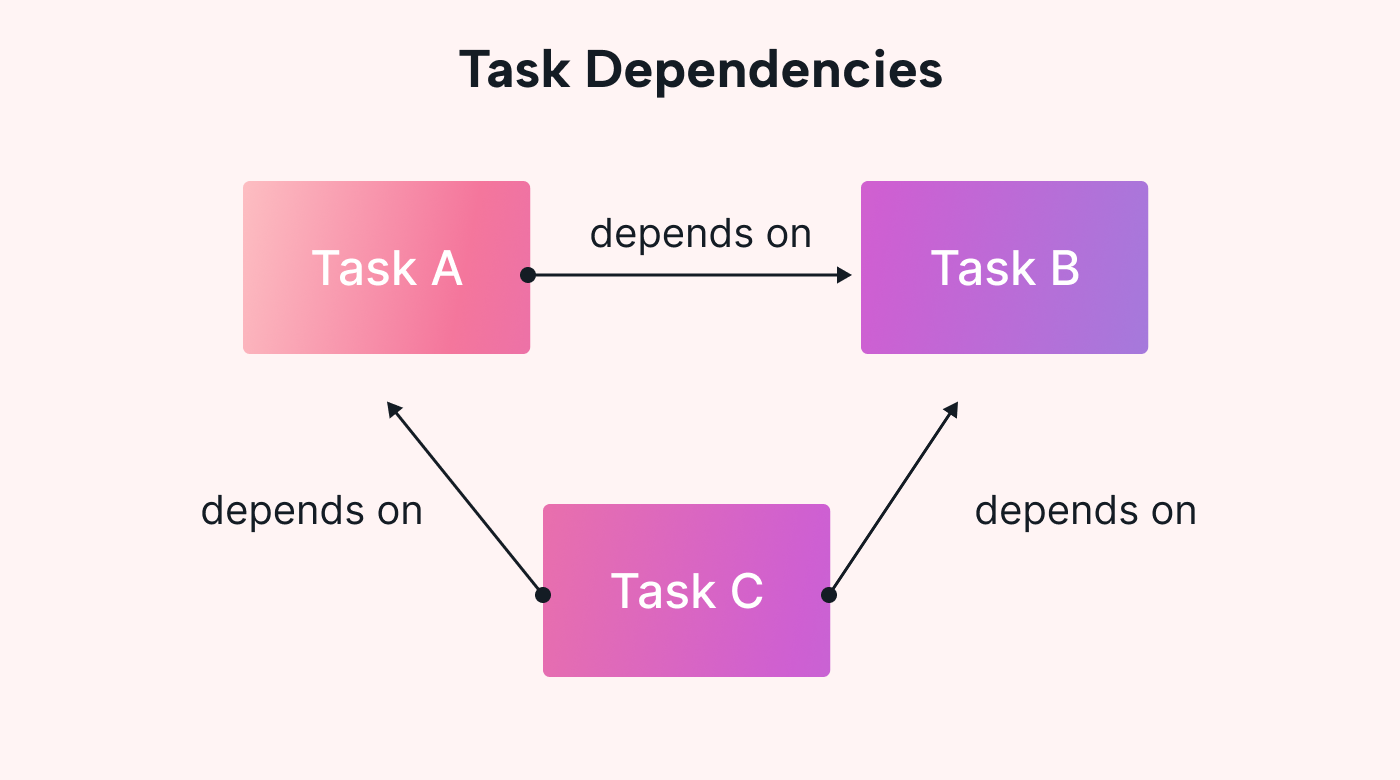Projects can get complex.
With all the moving parts, team members involved, and unexpected changes that can happen, someone has to keep an eye on the big picture of a project workflow.
That’s why knowing how to create a project timeline is a vital skill in today’s business world.
Yes, it takes a little time to create. But it’ll save you many headaches along the way.
In this article, we’ll cover everything you need to know about project timelines, including the following:
- What they are
- Why you need them
- Some great examples
- How to create one
- Common mistakes to avoid
With this information, you’ll be on your way to boosting your productivity and reducing costs — all while making life easier for you and your team.
Are you ready? Let’s start with the basics.
What is a project timeline?
A project timeline is a visual representation of a project from start to finish. It lays out the tasks and milestones you need to complete to achieve your project goals.
Think of it as a roadmap for any given project.
It clearly demonstrates the following:
- What needs to be done
- When it needs to be done
- Who’s responsible for completing each task
With a project timeline, you can see the overall picture and plan accordingly. This broad view of your project makes project timelines an essential tool for project management.
What does a project timeline include?
A project timeline typically includes the following key components:
- Project schedule: The dates on which the project begins and ends
- Task list: The individual tasks and subtasks required to complete the project, broken down into smaller subtasks as necessary
- Time frame: The time required to complete each task
- Task dependencies: Tasks that must be completed before others can begin
- Key milestones: The completion of major tasks or other accomplishments within the basic timeline
- Deadlines: When each task or milestone needs to be completed
What are the benefits of a project timeline?
In this section, we’ll cover why project timelines are so beneficial and why they can be used in most projects.
Increased productivity
When everyone on a team knows what to do and when to do it, it’s easier to stay on track and be productive. And that’s exactly what a project timeline does.
 |
A project timeline breaks a project down into smaller tasks and assigns specific goals for completion. As a visual to guide them, it helps your team stay focused — even when the end goal seems so far away.
Think of a timeline like planning a road trip. Without a map or itinerary, it’s easy to get lost or sidetracked. But when you have a clear plan, you can drive to your destination with ease since you’ll know where you need to be and when.
The same goes for a project timeline. Your team knows what they need to do and when they need to do it. As a result, they can better manage their time and resources, which can lead to faster completion of tasks and, ultimately, the project as a whole.
Improved communication and collaboration
In a recent report, the Association of Project Management found communication to be the most important dynamic condition in project success.
A high-level project timeline ensures that everyone involved in the project is aware of their responsibilities, timelines, and milestones. When the entire team is working along the same timeline, effective communication and collaboration become easier.
Team members can work together to identify potential issues or roadblocks and come up with solutions to them before they become even bigger problems.
In other words, a project timeline can act like a common language that brings individual team members together and fosters a sense of shared purpose.
For example, if one team member finishes their assigned task earlier than expected, they can communicate this to other team members and help identify potential areas to speed up the project.
Ultimately, having a shared understanding of a project’s basic timeline can help foster a sense of teamwork and collaboration among team members.
Simplification and clarity
One of the biggest benefits of a project timeline is the clarity it provides. Instead of feeling overwhelmed by a complex project, individual team members can see exactly how the project will proceed — and what it’ll take to finish it.
 |
Giving this structure to a complex project helps reduce the team’s stress levels and increases their confidence in the project’s ultimate success.
With a project timeline, team members are no longer faced with the overwhelming prospect of completing an entire project at once. Instead, they can focus on finishing individual tasks within the context of the larger timeline.
Having a clear project timeline also helps reduce the risk of unexpected delays or roadblocks. Team members can identify potential issues in advance and incorporate contingency plans. They can then better prepare for possible challenges and ultimately reduce the likelihood of stress arising from unexpected setbacks.
Some great project timeline examples
Project timelines are a powerful tool for many types of projects. Here are some examples of scenarios in which timelines can be used.
When planning a marketing campaign
Imagine you’re launching a new product, and you want to build a successful marketing campaign.
First, write down your primary tasks and subtasks. For instance, let’s say you need to conduct market research, develop marketing materials, and launch your campaign.
Then, estimate how much time you’ll need for each task, such as three weeks per task.
Finally, build a visual timeline to show when each task is due and how it depends on the others.
Even as you get deeper into the project, the project goals and their progression will remain clear for your team.
When planning an event
Now, imagine you’re planning an event. As part of this process, you’ll list all the required tasks, such as finding a venue, contracting a caterer, and creating promotional materials.
Then, estimate how long each task will take and arrange them in order. (Remember, certain tasks or subtasks might depend on others.)
For example, you’ll need to establish the venue before you can guarantee the event date. And you’ll need to have the date confirmed before you can create the promotional materials.
A linear timeline keeps these details clear and organized and helps your event run smoothly.
How to create a successful project timeline
1. Define the project scope and objectives
Having an in-depth knowledge of your project is an essential first step to creating a high-level project timeline.
So before you start mapping out the timeline, you need a clear understanding of what the project is meant to accomplish and the project’s scope.
A project scope outlines the goals, objectives, and deliverables of your project. It also includes any project requirements or constraints. Ultimately, it gives all team members a clear understanding of what the project includes and doesn’t include.
By investing time and effort into establishing a clear project scope during the planning phase, you’ll lay a solid foundation for creating a well-structured and achievable project timeline.
2. Create a task list
Next, it’s time to identify the specific tasks required to complete the project. That involves breaking the project down into smaller, more manageable tasks and listing each task required for each stage of the project.
It’s important for the task list to include as much detail as possible, so that each task is clear and well-defined.
For example, if training is required to use a new company software, you wouldn’t simply list “train for new software.”
Instead, you’d break it down into the following subtasks:
- Establish training objectives
- Develop training materials
- Schedule training sessions
3. Identify the task owners
Everyone involved in the project should have a clear understanding of who’s responsible for each task and subtask.
Communicating these responsibilities during the planning process is essential — it helps to ensure everyone understands their role in the project’s success.
4. Determine the task dependencies
Some tasks are in relationship to others — in fact, they can even be dependent on each other for completion. These are called dependent tasks.
 |
Understanding task dependencies is crucial to helping the project stay on track and end on time. A timeline explicitly states where the dependencies are and specifies the timeline accordingly.
For a construction project, a team might frame the walls the first week and install the electrical wiring the second week. With a visual timeline, the team can see that the second task is contingent on the first.
5. Estimate each task’s duration
Estimating task durations involves considering the resources required for each task, the availability of those resources, and any potential obstacles or delays that may arise.
It’s important to be realistic when estimating task durations — specifically, to account for any roadblocks that might come up.
6. Sequence the tasks
Once you’ve listed the tasks and their duration, put them in the order in which you need to complete them. Proper sequencing will include accounting for any dependencies.
It’s important to ensure that the tasks are sequenced in a way that makes sense and is achievable. You must consider the available resources and the overall goals.
7. Create the project timeline
Use a project management tool to plot out each task on a linear timeline based on its estimated duration, sequence, and delivery dates.
A project management tool streamlines the timeline creation process, allowing you to make easy adjustments when necessary.
8. Continuously review and modify the project timeline
The project timeline is a living document that’ll evolve throughout the project.
In the real world, change is the only predictable variable. You may need to move tasks around to account for unexpected delays or a change in priorities. You may lose a team member for various reasons or experience other constraints.
Therefore, it’s essential to review the timeline throughout the project to ensure that it remains relevant and achievable.
9. Communicate the project timeline
Finally, you should communicate a simple timeline to all the stakeholders involved in the project. And it’s best to do this with an online, collaborative, visual tool.
The stakeholders of a project may include the following:
- Team members
- Managers
- Clients
- Other relevant parties
Clear communication of the timeline helps ensure that everyone is on the same page. Regular updates and open communication foster collaboration and keep the project on track.
Common project timeline mistakes to avoid
Not defining clear objectives
One of the biggest mistakes in creating a project timeline is failing to define clear objectives.
And without that clarity, a team can’t determine what tasks they need to complete, how long they’ll take, and who will be responsible for completing them.
 |
This vagueness can lead to confusion, delays, and missed deadlines.
To avoid this mistake, schedule a project kickoff meeting to establish clear project objectives from the start. Clearly communicate the goals, deliverables, and key dates to make sure everyone understands the project’s purpose and can align their efforts accordingly.
Not understanding task specifics
Not understanding your tasks can also lead to problems as well.
This misunderstanding can manifest in different ways, such as the following:
- Failing to identify all tasks
- Under-estimating task durations
- Not understanding which tasks are dependent on each other
These mistakes can lead to an unrealistic and haphazard timeline.
It’s best to take your time and make an accurate project scope the first time.
Not revising and communicating
A project timeline isn’t a static document that’s created and then left untouched — it requires regular revision and adaptation throughout the project’s lifecycle.
Not revising a project timeline as variables change within the project can lead to inefficiency and misalignment.
And poor communication can result in misunderstandings, missed updates, and difficulty collaborating.
For your timeline to remain effective, be sure to:
- Regularly evaluate progress
- Identify potential roadblocks
- Make the necessary adjustments
Then, keep the stakeholders informed about any changes or updates to the timeline to ensure everyone is on the same page and working together smoothly.
Create your project timeline today
You now have all the info you need to create a project timeline that’ll be a game-changer for your project management.
All you need now is the right software. Motion’s powerful AI software can automate 90% of project planning. Plus, it’s a tool that your team will actually want to use!
Try it for free today!





